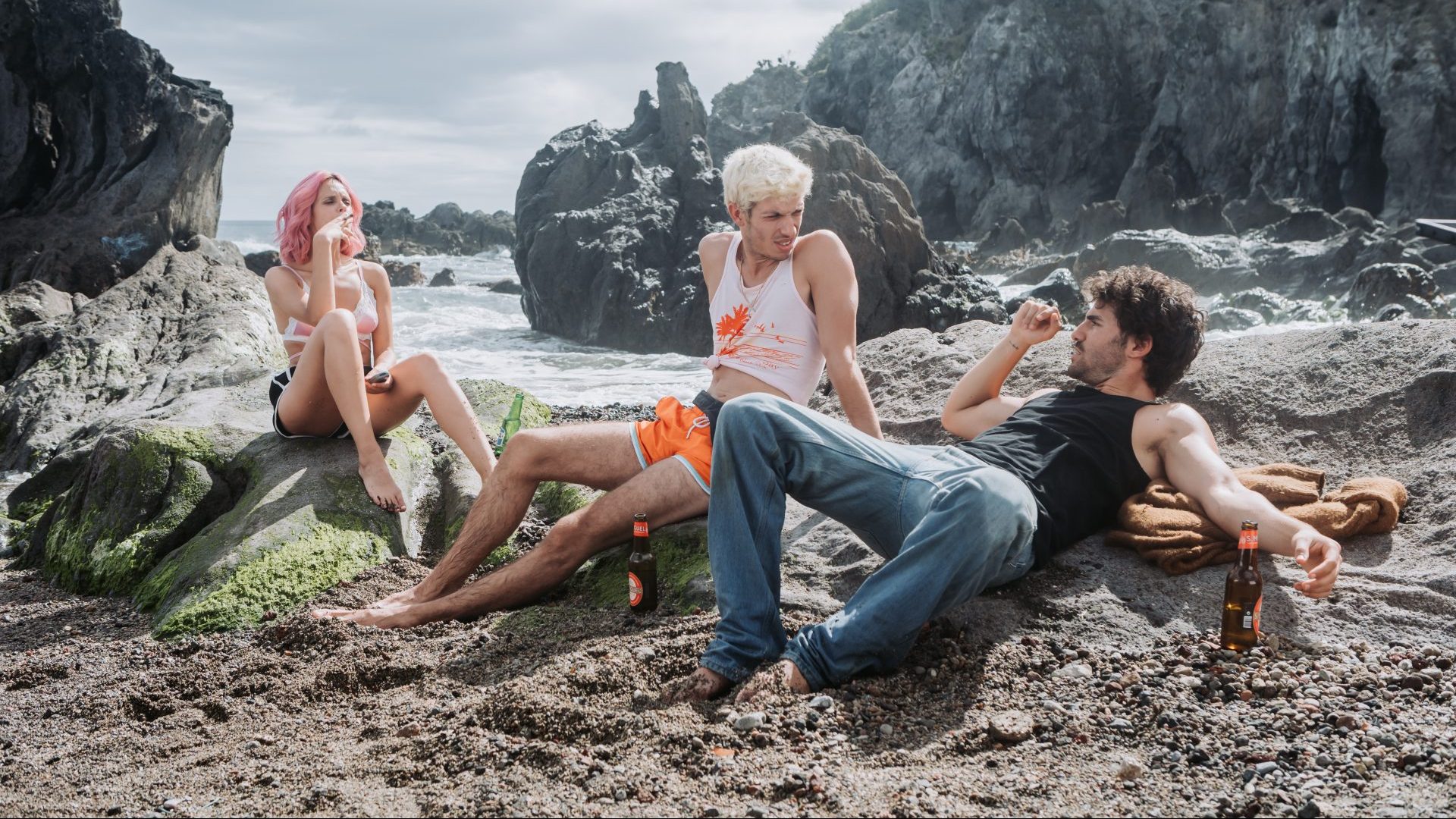We huddled in the tiny garage that served as a pop-up tapas bar and impromptu canned-beer outlet as the rain gathered its strength for an even more brutal assault on the narrow village streets of Raminho.
Portuguese conversation mingled with North American English as we rued having failed to remember that on the Azores, the distance of just a few miles can deliver you into a different climate.
It was not what potential visitors to this rugged volcanic archipelago would expect from the tourist brochures that bill it as the “Hawaii of the mid-Atlantic”. Or from the hit Netflix series Rabo de Peixe (Turn of the Tide), a glossy action thriller that weaves lingering shots of the islands’ dramatic landscape into the sort-of-true story of what happened after a shipwrecked yacht disgorged a massive stash of cocaine on to Azores shores in 2001.
I had been drawn to what is officially an autonomous region of Portugal for a different reason – to follow in the footsteps of Diana Marcum, a Pulitzer Prize-winning journalist who found herself so curiously drawn to both the place and to the large numbers of Azoreans who have left for new lives in the USA that she turned her repeat visits into an autobiographical narrative. The Tenth Island was published to great acclaim in 2018. I hoped to meet Marcum on my travels through four of the islands.
For now though I was hiding from the rain in Terceira, the third-largest Azorean isle. We had come here to watch a tourada à corda, or bullfight by rope, a tradition said to have been inspired by the use of unleashed bulls to drive off a Spanish invasion in 1581.
The bull is partially restrained by eight pastores holding a long rope. It is taunted but always released unharmed to fight again a few weeks later – though we couldn’t help but feel sorry for the poor creature as it slipped on the greasy cobbles while people scrambled over garden walls and gates lest they be cornered and injured.
We soon found ourselves talking to a man of maybe 60, visiting from Ontario, who – like many from North America – was in the islands for an extended summer stay. He had his own house on Terceira – not unusually, as links with Canada, New England and in particular California are so strong that the Azorean diaspora in North America talk about belonging to the “tenth island” – there being nine true islands in a loose archipelago scattered across hundreds of miles of ocean. Indeed, in many ways, the islands are psychologically closer to America than to mainland Portugal, thanks to many years of often relentless migration.
Diaspora comes from the Greek diaspeirein, meaning, literally, “scattered across”. Some European countries have exported their people so efficiently that they are not just scattered across other continents, but may actually outnumber those remaining in the “mother country”: there are an estimated 30.5 million “Irish” in the USA – six times the population of Ireland; and more than 4 million “Scots” in Canada.
The initial migrations in these cases were driven respectively by famine and dispossession, with ruthless landlords the common factor. But the Azores probably hold the title of Europe’s greatest people-exporter, per head of population. Migration has been a fact of life here since the rugged islands were first settled by Portugal in the early 15th century.
Ruthless state-sponsored landlords ensured that these farming people could never aspire to lift themselves from poverty, and their exit proceeded in waves for as long as extreme poverty prevailed right up to the middle of the last century. Once aircraft could make the 2,000-mile flight to America, Azoreans began to leave by plane too and, in the late 1950s, came the most recent big exodus, when a young Senator John F Kennedy waived immigration rules to create the 1958 Refugee Act and admit Azoreans fleeing a major eruption on the island of Faial.
The nine islands have a combined population today of about 240,000, yet people of Azorean descent make up the overwhelming majority of the 1.7 million of Portuguese descent in the USA, as well as perhaps 300,000 in Canada. Azoreans have, over generations, applied their agricultural knowledge to become mainstays of farming in places like California’s Central Valley, where about 250,000 live.
This large diaspora share online with the folks “back home” the islands’ almost constant succession of summer festivals, driven by – or perhaps indulging in – what the Portuguese call saudade – “an emotional state of melancholic or profoundly nostalgic longing for a beloved yet absent something or someone”.
Only the death of the Portuguese dictator Salazar in 1970, amid the crumbling of the Portuguese empire, began to staunch the flow, along with later accession to the EU. Today the islands enjoy a special status and special funding as an EU “outermost region”, helping to stimulate economic development across a wider range of sectors, though tourism remains the most important, ahead of agriculture and fishing.
But the story of migration is never far away: the little town of Ribeira Grande on the largest island, São Miguel, has created in the old fish market a wonderfully informative museum dedicated to the story of migration. There I spotted an elegant carving of a plough and two oxen, by José Monez, who emigrated to Ontario in 1973.
The woman on reception told me how few of her generation had ever visited any of the other islands in the group. Inter-island travel was until relatively recently prohibitively expensive: it was cheaper to go to Lisbon – perhaps even to America. Nowadays there are subsidised flights between the often distant islands. Each has its own peculiarities – alongside a powerful connecting cultural thread.
The migrants took with them powerful religious and musical traditions: Hawaii can thank the arrival there of the rajão and the braginha from the Azores and Madeira for the ukulele. Even the tourada à corda has found its way into tenth-island life in Ontario and California.
Marcum was first persuaded to make the journey to Terceira as an exercise in recuperation from redundancy (as modern technology swept through newsrooms) and in an attempt to “find herself”. Raised by foster parents who died when she was only 15, Marcum knew nothing of her own antecedents. She stayed in houses found for her by members of the diaspora and, returning subsequently to visit other islands, found herself increasingly at one with herself.
In an interview in the Portuguese American Journal, shortly after her book was published in 2018, Marcum was asked what drew her to the islands and whether she had Portuguese relations, to which she replied: “Not that I know of and I certainly don’t look Portuguese. But I find it mysterious that I felt such a pull from the first time I set foot in the Azores.
“There was instant recognition like when you meet someone and feel like you’ve known them forever. I have suspicions that I am descended from Jews who fled to the Azores during the Spanish Inquisition – but it’s nothing I know for sure, just this weird unsubstantiated hunch.”
When I visited Terceira we found ourselves in the midst of a 10-day festival, and grabbed a bite to eat with local beautician Anna and her partner, Marc: “There are eight Azores and then us: we are not an island, just one long party!” she laughed. In recent years, however, this island has all but lost its single biggest link with the USA, with the departure of 95% of the personnel stationed at the major American base at Lajes Field.
It once employed 3,000 American servicemen and civilians, and many more local people indirectly. Now there are just 150 or so left. “It has hit Praia da Vitória badly,” said Anna, of the port and resort town near the base. I expected to find a ghost town, but the Portuguese sense of pride in the upkeep of public spaces is still very clear to see.
Perhaps more ominous, given current geopolitical sensitivities, is Chinese interest in the vacuum left by the Americans. Earlier this year, China formally offered to fund projects in the areas of “culture, research and science” in the Azores. It has made no secret of its interest in seeing the Azores become a natural staging point between its interests in the Caribbean and Africa. Perhaps, though, the Chinese arrival might mitigate a less desirable American legacy, with Terceira’s many fast food outlets fuelling an epidemic of obesity.
Rabo de Peixe also traces the aftermath of what happens when the wider world intrudes on the Azores, the washed-ashore cocaine wreaking havoc and disaster on a local community starved of opportunity. My own experience is the far more peaceful aspects of these outrageously beautiful islands: the community swimming pools, hewn from the lava landscape itself; the shy cloud-shrouded summit of the towering active volcano of Pico, on the eponymous island; the bright green punctuation of raggle-taggle walls of black lava by the World Heritage vineyards there; the unrelenting hospitality; the whales; the eternal hydrangea hedges; the cozido meat and vegetable stew, slow-cooked in the hot springs of Furnas…
I wanted to hear Diana Marcum’s own take on saudade, and asked Millicent Borges Accardi, a writer for the Portuguese American Journal, to email her on my behalf. The email that came back from Marcum’s address made my heart miss a beat: she had died the very day we got in contact.
Marcum and her partner had bought a house on Terceira with a friend and all went there together for the first time in June of this year: they were probably there when I was. But after two weeks salving her saudade, Marcum collapsed and was diagnosed with a brain tumour. She was operated on in California but slipped into a coma and died on August 9.
The long, laudatory obituary in the Los Angeles Times the following day told how Marcum quite literally never knew where she was from. The Azores, that great exporter of people, had found an import and blessed her with a true sense of belonging. I never met Diana Marcum but feel I have lost a dear friend: her words drew me to the Azores and she was there with me at my shoulder.
Season one of Rabo de Peixe is available to stream on Netflix; season two is in production. The Tenth Island by Diana Marcum is published by Little A books



